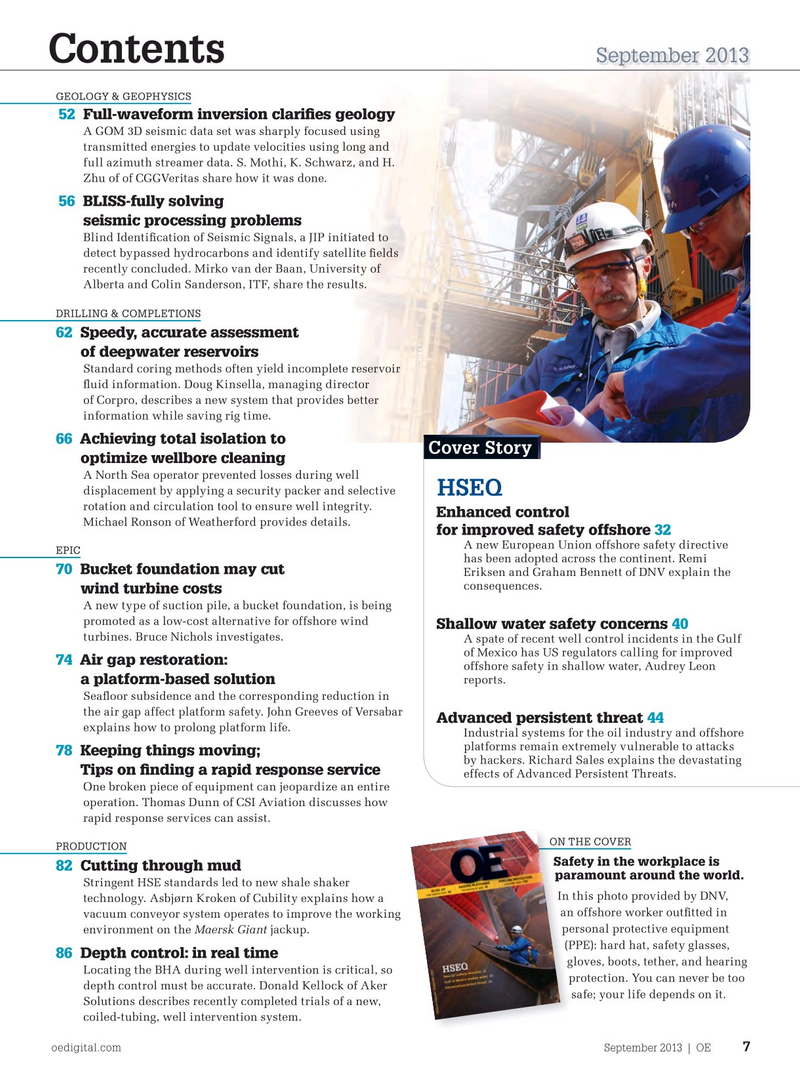
Page 5: of Offshore Engineer Magazine (Sep/Oct 2013)
Read this page in Pdf, Flash or Html5 edition of Sep/Oct 2013 Offshore Engineer Magazine
September 2013
Contents
GeOLOGY & GeOPhYSIcS 52 Full-waveform inversion clarifes geology
A GOM 3D seismic data set was sharply focused using transmitted energies to update velocities using long and full azimuth streamer data. S. Mothi, K. Schwarz, and H.
Zhu of of CGGVeritas share how it was done.
56 BLISS-fully solving seismic processing problems
Blind Identifcation of Seismic Signals, a JIP initiated to detect bypassed hydrocarbons and identify satellite felds recently concluded. Mirko van der Baan, University of
Alberta and Colin Sanderson, ITF, share the results.
DrILLInG & cOMPLetIOnS 62 Speedy, accurate assessment of deepwater reservoirs
Standard coring methods often yield incomplete reservoir fuid information. Doug Kinsella, managing director of Corpro, describes a new system that provides better information while saving rig time.
66 Achieving total isolation to
Cover Story optimize wellbore cleaning
A North Sea operator prevented losses during well displacement by applying a security packer and selective
HSEQ rotation and circulation tool to ensure well integrity.
Enhanced control
Michael Ronson of Weatherford provides details.
for improved safety offshore 32
A new European Union offshore safety directive ePIc has been adopted across the continent. Remi 70 Bucket foundation may cut
Eriksen and Graham Bennett of DNV explain the consequences.
wind turbine costs
A new type of suction pile, a bucket foundation, is being promoted as a low-cost alternative for offshore wind
Shallow water safety concerns 40 turbines. Bruce Nichols investigates.
A spate of recent well control incidents in the Gulf of Mexico has US regulators calling for improved 74 Air gap restoration: offshore safety in shallow water, Audrey Leon reports.
a platform-based solution
Seafoor subsidence and the corresponding reduction in the air gap affect platform safety. John Greeves of Versabar
Advanced persistent threat 44 explains how to prolong platform life.
Industrial systems for the oil industry and offshore platforms remain extremely vulnerable to attacks 78 Keeping things moving; by hackers. Richard Sales explains the devastating
Tips on fnding a rapid response service effects of Advanced Persistent Threats.
One broken piece of equipment can jeopardize an entire operation. Thomas Dunn of CSI Aviation discusses how rapid response services can assist.
On the cOver
PrODuctIOn
Safety in the workplace is 82 Cutting through mud paramount around the world.
Stringent HSE standards led to new shale shaker
In this photo provided by DNV, technology. Asbjørn Kroken of Cubility explains how a an offshore worker outftted in vacuum conveyor system operates to improve the working environment on the Maersk Giant jackup. personal protective equipment (PPE): hard hat, safety glasses, 86 Depth control: in real time gloves, boots, tether, and hearing
Locating the BHA during well intervention is critical, so protection. You can never be too depth control must be accurate. Donald Kellock of Aker safe; your life depends on it.
Solutions describes recently completed trials of a new, coiled-tubing, well intervention system. oedigital.com September 2013 | OE 7
OE_0913_toc.indd 7 8/18/13 7:43 PM

 4
4

 6
6